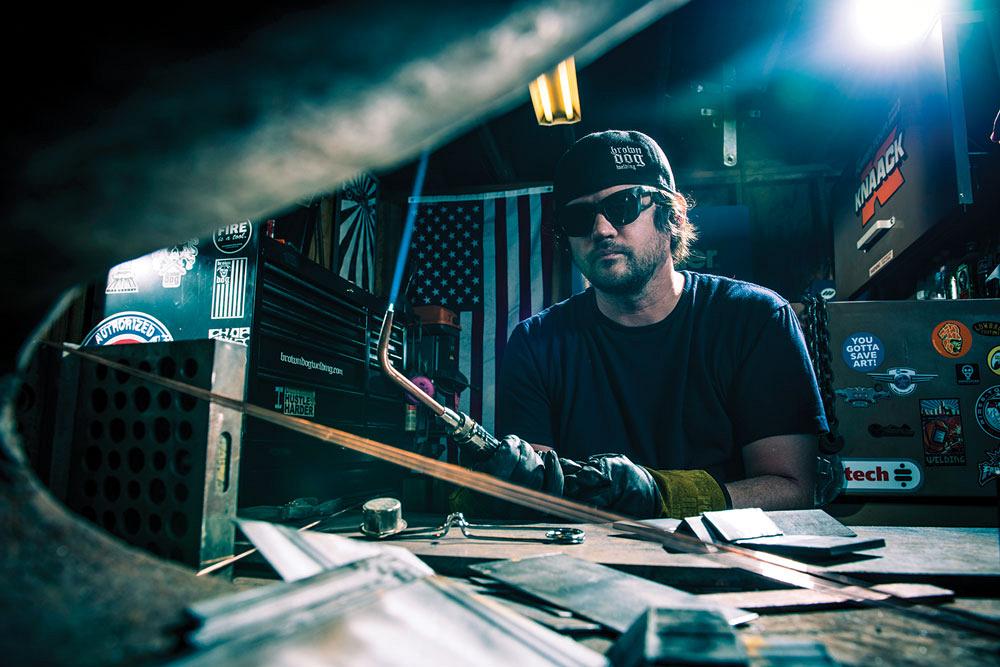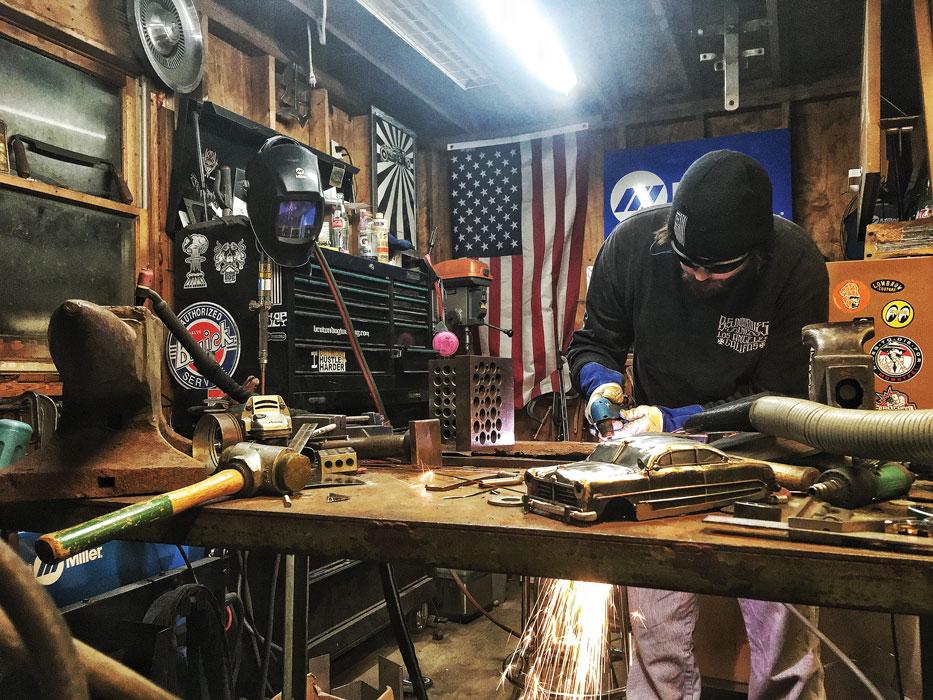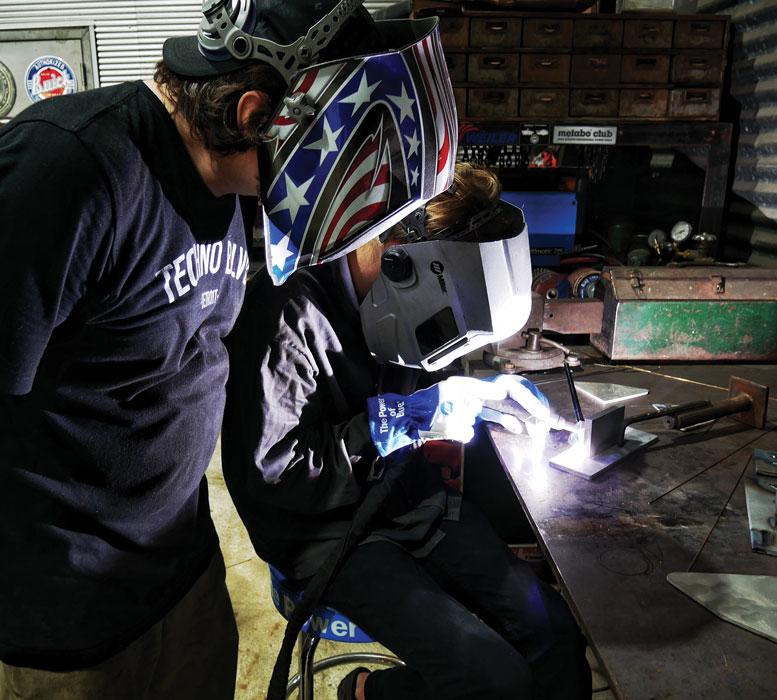Owner, Brown Dog Welding
- FMA
- The Fabricator
- FABTECH
- Canadian Metalworking
Categories
- Additive Manufacturing
- Aluminum Welding
- Arc Welding
- Assembly and Joining
- Automation and Robotics
- Bending and Forming
- Consumables
- Cutting and Weld Prep
- Electric Vehicles
- En Español
- Finishing
- Hydroforming
- Laser Cutting
- Laser Welding
- Machining
- Manufacturing Software
- Materials Handling
- Metals/Materials
- Oxyfuel Cutting
- Plasma Cutting
- Power Tools
- Punching and Other Holemaking
- Roll Forming
- Safety
- Sawing
- Shearing
- Shop Management
- Testing and Measuring
- Tube and Pipe Fabrication
- Tube and Pipe Production
- Waterjet Cutting
Industry Directory
Webcasts
Podcasts
FAB 40
Advertise
Subscribe
Account Login
Search
Future welders: What to know about welding as a career
- By Josh Welton
- Updated February 3, 2023
- December 5, 2018
- Article
- Arc Welding

"I want potential tradespeople to go into their career with both eyes open, and part of that is putting an end to the misleading numbers the industry has pushed into our everyday vernacular through the media." Josh Welton, Brown Dog Weling
While I want everyone to try welding, and I’d dig it if everyone then found that they loved welding, it’s not everyone’s bag. It’s why exposing kids at a young age to blue-collar trades is important, so they know what their options are. We’ve done a terrific job of removing any scarlet letter previously associated with getting your hands dirty for a living. There’s as much respect for the trades now as there ever was. But I want potential tradespeople to go into their career with both eyes open, and part of that is putting an end to the misleading numbers the industry has pushed into our everyday vernacular through the media.
Throughout the years we’ve been subjected to claims from industry, manufacturing as a whole, and welding in particular about why young men and women should choose a trade to make their living. They say there aren’t enough skilled workers in the U.S. to fill the demand. I’ve heard that the average age of a welder in this country is 55. But the thing is, we’ve been hearing the same thing for over 20 years. At least that number is more accurate than the $45,000 average starting salary that some “advocate” organizations would like you to believe. Heck, according to the U.S. Department of Labor, the average overall salary for a welder is $45,000. That’s not a small discrepancy.
The root issue is that the industry and its lobbyists are preying on fear. They target those of us looking to make a little money with minimal education. They bank on our anxiety of being jobless, directionless, and poor. They tap into our basic desire to be contributing members of society. In doing so they count on our ignorance by pushing numbers and concepts without context.
We need to demand more, but collectively we first need to understand why. It starts with those numbers.
Average Age of a Welder
First, the “average age” talking point that we’re all familiar with is misrepresented. The age 55 seems to be popular in welding. If you conduct a simple Google search, you’ll see the same authoritative source quoting that number again and again without providing any proof of where they are getting that number.
DataUSA, a cool project from MIT that launched in 2016, collects and consolidates government data and presents it in an easily digestible format for those of us who don’t have time to spend researching the validity of an industry claim. Anyways, it lists the average age of an American welder at right around 401. That’s just below the national average for all workers in the U.S.!
For argument’s sake, let’s pretend that 55 years old is accurate. According to the DOL, from 2006 to 2016 the number of industry workers 55 years of age and older grew by 10.2 million2. In the same timeframe, the number of workers ages 35 to 54 within the industry decreased by 4.2 million. Overall, workers 65 and older within our labor force is projected to be the fastest-growing segment in the next decade.
What does all of this mean? People are working longer, which makes sense. We’re living longer, the cost of living continues to rise, and “30 and out” jobs are getting harder and harder to find. More important is what it doesn’t mean. It doesn’t mean that our economy is or will be bursting at the seams with high-paying welding jobs. Nor does it mean that suddenly all experienced and knowledgeable workers are vanishing into retirement.
Average Welder Pay
Second, let’s discuss our pay. The same source making the “average age” claims states that the average starting salary for a welder is $45,000. I’ve seen similar numbers pop up in articles and internet memes quite a bit. You know, the one comparing a welder’s starting salary at $50,000 to that of a four-year college graduate’s at $25,0003.
According to DataUSA, however, the median overall salary for a male welder is $43,0004. Not the starting salary, the overall salary. The DOL states that only 25 percent of all welders make more than $50,0005. Obviously, this varies depending on where you live, and there will be some anomalies in certain sectors, like oil. The cost of entry for those outliers increases as well, in travel time, equipment costs, and job volatility. And those numbers end up balancing out with minimum-wage factory jobs. The point is the typical person is going to start out at $10 to $15 per hour, or about half of $45,000.
So why lie? Because telling a 20-year-old kid that men and women with 15 years’ more experience are making $45,000 a year is a much harder sell.
Our metal fabrication, machine, and transportation manufacturing industry as a whole lost almost 400,000 jobs from 2006 to 2016. They also put out $33 billion more in GDP in 2016 than in 20066. So they outsource and automate more jobs to increase profits, and then when they can’t find good help domestically that won’t cut into those profits, they claim that suddenly there’s a great talent loss. Then that’s an excuse to bring in outside help, or to invest in more automation, or to outsource more.
The powers that be don’t make money by being dumb, but they count on our ignorance to increase their bottom line. “Sorry we can’t pay more, it’s not in our budget.” Then, guess what? It’s not in your budget to hire good help and you get what you deserve. Only they don’t. They get bailed out, they get incentives to source “global” labor, or they get subsidized training. What they don’t do is make less money.
The more of us they get fighting for factory or field jobs, the less they have to promise in the form of salary, benefits, and workplace amenities. We end up in a race to the bottom, settling for less because the ratio of workers to domestic jobs is growing higher. The more they lobby Capitol Hill for our tax dollars to go toward training funds, the less they need to provide in on-the-job training. Even if your employer does offer training, too many times they won’t pay for a more skilled you. “But hey, we trained you, that’s worth something!” Yeah, if you pay me more. But not in and of itself. Then the same employer will crow on about their high turnover rate and lack of loyalty.
Welding as a Career Choice
We hear about companies unable to fill skilled positions, yet all across America we have under- or unemployed welders wondering if they should switch careers. It’s not like we stopped wanting to get our hands dirty. There are just more options to make more money now than there were before.
If there was a legitimate skills gap and the industry and the government were serious about closing it, it could be done in less than five years. U.S. manufacturers just have to be willing to offer more money and better benefits to invest in the American workforce. More students would go through two-year vocational programs, and more people would enter four-year apprenticeships. Fewer experienced tradespeople would want to leave for greener pastures. This has to be a concerted investment in people, not a quick $1,000 signing bonus or a dollar more an hour in wages.
And if they’re for real about keeping skilled workers in the trades, they need to expand the pool of potential employees. If all you want to do is appeal to dropouts currently flipping burgers or getting stoned watching “The Price is Right,” as a rule you’re not going to attract the best and the brightest. It’s not about training up just anybody, because not everyone is cut out to put the “skilled” in skilled trades. It’s about luring away smart and talented people who’d otherwise be successful professionals in other industries.
All that being said, it’s also about more than money. That’s where exposing the trades to middle school and junior high students is important. Let them discover the joy of running a bead or fabricating a catwalk or milling a hub. Or let them find out they hate it. Some will find out they’re better suited to stitch up head injuries than fuel cells, and vice versa.
Either way, you’re going to attract people who want to be where they are, instead of being everyone’s Plan B.
I know it’s not cut and dried. On one hand, I’m telling you welding is awesome; on the other hand, I’m telling you it’s probably not the bill of goods you’ve been sold. Both can be true. Both are true. I want a career in welding to be as enriching and fulfilling as possible, and right now we’re settling for less.
Let’s demand more.
Notes:
https://datausa.io/profile/soc/514120/#age_gender
1https://www.bls.gov/emp/tables/civilian-labor-force detail.htm
2https://imgur.com/FEj1Bjp
3https://datausa.io/profile/soc/514120/#age_gender
4https://www.bls.gov/oes/current/oes514121.htm
5https://www.bls.gov/emp/tables/industry-employment and-output.htm
About the Author

About the Publication
subscribe now

The Welder, formerly known as Practical Welding Today, is a showcase of the real people who make the products we use and work with every day. This magazine has served the welding community in North America well for more than 20 years.
start your free subscription- Stay connected from anywhere

Easily access valuable industry resources now with full access to the digital edition of The Fabricator.

Easily access valuable industry resources now with full access to the digital edition of The Welder.

Easily access valuable industry resources now with full access to the digital edition of The Tube and Pipe Journal.
- Podcasting
- Podcast:
- The Fabricator Podcast
- Published:
- 04/16/2024
- Running Time:
- 63:29
In this episode of The Fabricator Podcast, Caleb Chamberlain, co-founder and CEO of OSH Cut, discusses his company’s...
- Trending Articles
Sheffield Forgemasters makes global leap in welding technology

Welding student from Utah to represent the U.S. at WorldSkills 2024

Lincoln Electric announces executive appointments

Engine-driven welding machines include integrated air compressors

ESAB unveils Texas facility renovation

- Industry Events
16th Annual Safety Conference
- April 30 - May 1, 2024
- Elgin,
Pipe and Tube Conference
- May 21 - 22, 2024
- Omaha, NE
World-Class Roll Forming Workshop
- June 5 - 6, 2024
- Louisville, KY
Advanced Laser Application Workshop
- June 25 - 27, 2024
- Novi, MI





























